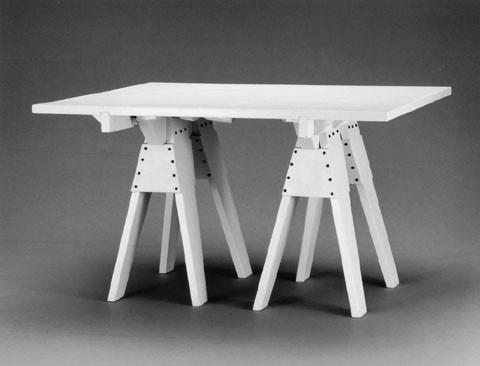
Table designed by Louis Comfort Tiffany and made by J. Matthew Meier and Ernest Hagen, New York City, 1885. Pine; white enamel paint. H. 28 1/8", W. 39 7/8", D. 48". (Courtesy, ©The Art Institute of Chicago, All rights reserved. Anonymous gift 1981.172)

Detail of the bottom of the table illustrated in fig. 1.
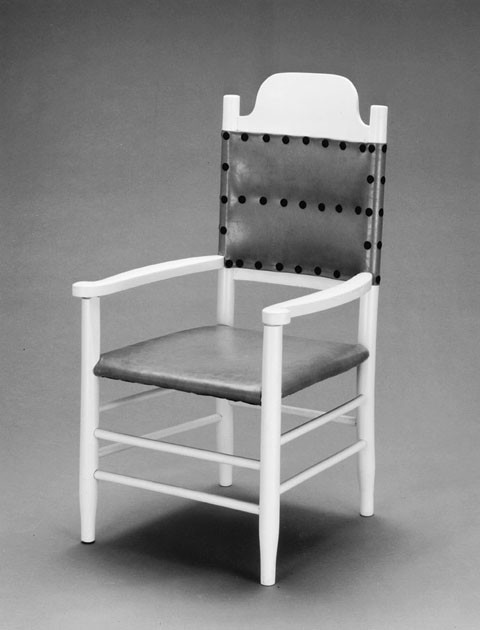
Armchair designed by Louis Comfort Tiffany and made by Barnes Brothers for J. Matthew Meier and Ernest Hagen, New York City, 1885. Maple; white enamel paint, leather upholstery. H. 42", W. (seat) 22", D. (seat) 21". (Courtesy, ©The Art Institute of Chicago. All rights reserved. Anonymous gift 1982.65.)
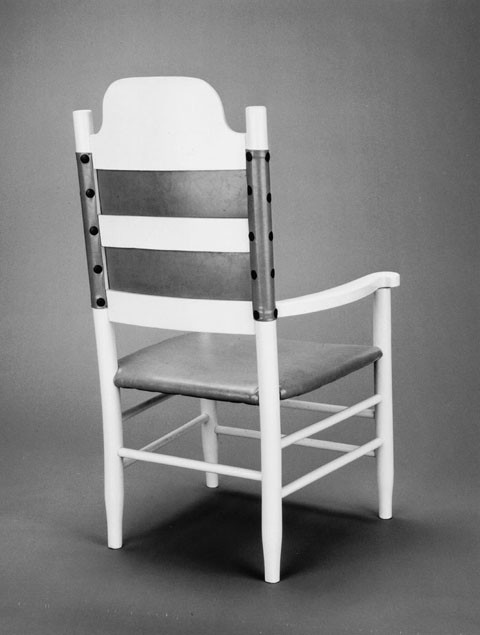
Rear view of the armchair illustrated in fig. 3.

Side chair designed by Louis Comfort Tiffany and made by Barnes Brothers for J. Matthew Meier and Ernest Hagen, New York City, 1885. Maple; white enamel paint, leather upholstery. H. 40", W. (seat) 17", D. (seat) 19". (Courtesy, ©The Art Institute of Chicago. All rights reserved. Anonymous gift, 1982.60.)

Rear view of the side chair illustrated in fig. 5.

Stanford White for McKim, Mead and White, Charles L. Tiffany family residence, 19 East 72d Street (Madison Avenue at 72d Street), New York City, designed 1882, built 1882–1885. Photograph, 6 5/8" x 8 5/8". (Collection of the New-York Historical Society.)
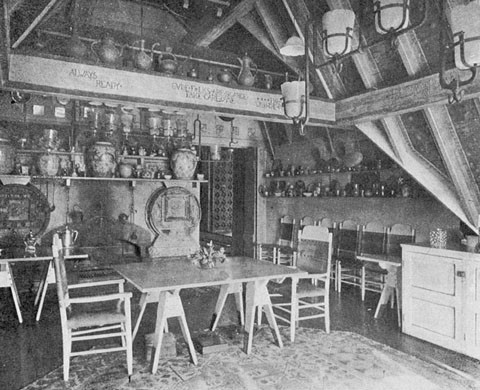
Breakfast room designed by Louis Comfort Tiffany for his apartment in the Charles L. Tiffany residence as it appeared ca. 1885–1900. Illustrated in the Architectural Record 10, no. 2 (October 1900): 195. Illustration, 4 5/8" x 5 3/4". (Courtesy, Ryerson-Burnham Library, Art Institute of Chicago.)

J. Matthew Meier and Ernest Hagen Order Book, entry for tables and chairs in the breakfast suite designed by Louis Comfort Tiffany, 1882. (Collection of the New-York Historical Society, gift of The Magazine Antiques.)
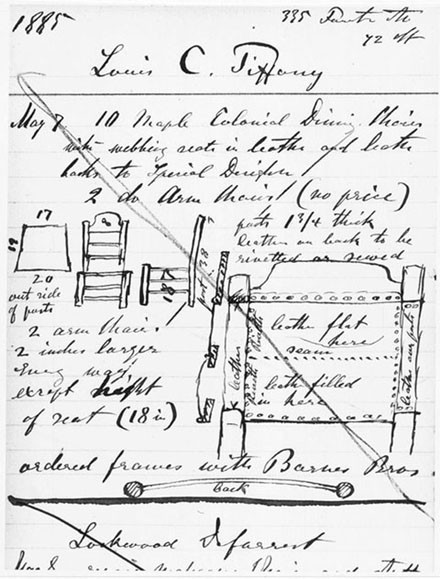
J. Matthew Meier and Ernest Hagen Order Book, entry for chairs in the breakfast suite designed by Louis Comfort Tiffany, May 7, 1885. (Collection of the New-York Historical Society, gift of The Magazine Antiques.)
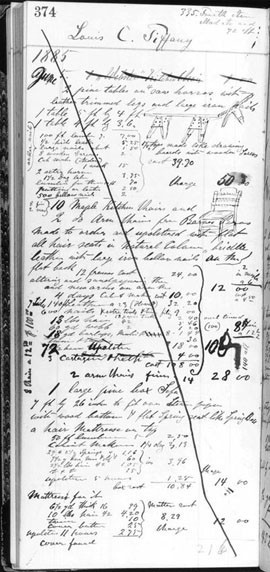
J. Matthew Meier and Ernest Hagen Order Book, bill (first page) for the breakfast suite designed by Louis Comfort Tiffany, June 5(?), 1885. (Collection of the New-York Historical Society, gift of The Magazine Antiques.)
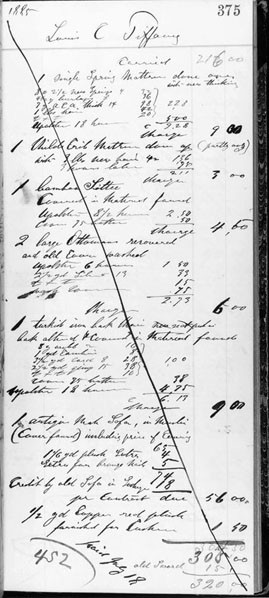
J. Matthew Meier and Ernest Hagen Order Book, bill (second page) for the breakfast suite designed by Louis Comfort Tiffany, June 5(?), 1885. (Collection of the New-York Historical Society, gift of The Magazine Antiques.)
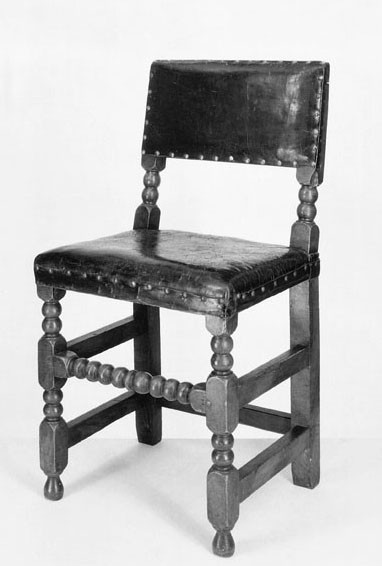
Side chair, Boston, 1665–1695. Soft maple and red oak. H. 36", W. (seat) 18", D. (seat) 15 1/4". (Courtesy, Winterthur Museum.)
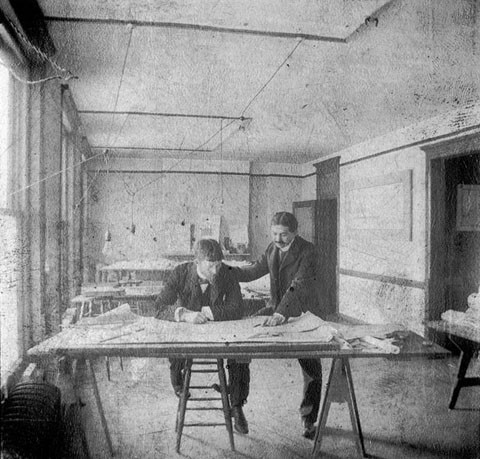
Drafting room of Hugh Garden (standing), Chicago, ca. 1895. Photograph, 4 3/8" x 4 1/2". (Collection of Mrs. William Dorr.)
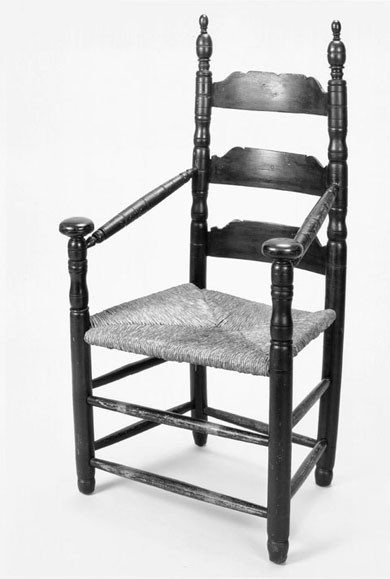
Great chair, Norwich, Connecticut, 1670–1710. Soft maple and black ash. H. 44 1/2", W. (seat) 23 1/2", D. (seat) 17". (Courtesy, ©The Art Institute of Chicago. All rights reserved. Wesley M. Dixon, Jr., Fund, 1985.240.)
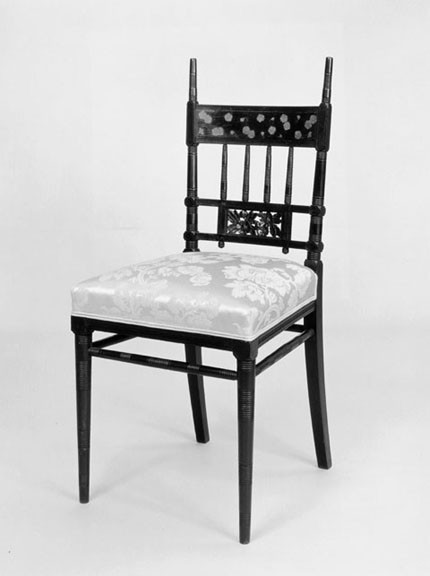
Side chair by Herter Brothers, New York City, ca. 1877–ca. 1879. Maple (stained black) with unidentified inlay woods. H. 37 3/4", W. (seat) 17 3/8", D. (seat) 16 3/4". (Courtesy, ©The Art Institute of Chicago. All rights reserved. The Mrs. Alfred J. Burdick Fund 1973.379.)
Documentary evidence now reveals that innovative furniture design must be included in the diverse interests of Louis Comfort Tiffany (1848–1933). Personal papers of this major presence in the American arts remain tragically elusive, if they survive, but his interest in furniture design fortunately can be shifted from speculation to documentation by linking contemporary evidence to a remarkable breakfast suite that has survived intact and recently become publicly known (see figs. 1, 3, 5). Tiffany commissioned the suite from Manhattan cabinetmakers J. Matthew Meier (1830–1913) and Ernest Hagen (1822–1889) for his apartment in the Tiffany family building, completed in 1885 at the northwest corner of Madison Avenue and 72d Street in New York City (fig. 7).
The suite documents Tiffany’s participation in the furniture reform movement, which originated in England and stressed practicality, simplicity, and economy. The two tables are the same width and height but different lengths so they could be used separately or placed together, and their tops are independent of the bases for convenient cleaning, moving, and storage (see figs. 1, 2). The two armchairs and ten side chairs (see figs. 3–6) are sturdy and comfortably large. All are made of cheap pine and maple, upholstered in leather, and painted with white enamel for cleaning ease. Construction details are intentionally conspicuous. For example, black paint accentuates the heads of the screws securing the table bases together and the tacks securing the leather to the chair backs. Parallels to these tables and chairs are unknown in contemporary and historic European or American domestic furniture.[1]
Tiffany’s suite survives in good condition. Donors requesting anonymity gave half of the furniture to the Mark Twain Memorial in Hartford, Connecticut, in 1976 and half to the Art Institute of Chicago in 1981 and 1982. Use of the suite by Tiffany and his descendants required repainting and reupholstering about a generation ago; the original appearance is not evident from the furniture, but illustrations and descriptions of it during Tiffany’s lifetime reveal that the present painted surfaces and brown leather upholstery are accurate. In 1988, the Art Institute restored black paint to the heads of screws and upholstery tacks.
Tiffany’s furniture has long survived the home for which it was designed. His order for the suite coincided with the architect’s submission of designs for the Tiffany family residence on April 9, 1882, and delivery of the suite coincided with the building’s completion on October 1, 1885. Tiffany’s father, Charles Lewis (1812–1902), commissioned the three-apartment structure: the first two floors above the street were intended for the elder Tiffany (but leased to a tenant); the level above it was for an unmarried daughter, Louise; and the two levels at the top—within a steeply pitched and gabled roof—were for Louis Comfort Tiffany’s family (fig. 7). The breakfast room was adjacent to the windows at the top of the projecting cylindrical turret on the southeast corner of the building overlooking Madison Avenue. Tiffany may have removed the furniture, perhaps without reinstallation, when he renovated the building and added three stories in 1909—seven years after buying it from his father’s estate. Tiffany could have continued using the furniture in the building until his death in 1933. Heirs would then have removed the furnishings before a later owner razed the building in 1939.[2]
The architectural design of the Tiffany residence was as carefully conceived as the breakfast suite to make an innovative aesthetic statement. Stanford White, of the architectural firm McKim, Mead and White, was undoubtedly responsible for many elements of the building. Louis Comfort Tiffany’s role in the design is problematical. He was assuredly the architectural liaison for his family in developing the unusual plan, and he probably originated features of the design that are eccentric in buildings by McKim, Mead and White. On the basis of interviews with Tiffany three decades after the building’s completion, Charles de Kay asserts that Tiffany designed the roof area and infers his responsibility for the architectural style—unusual among buildings by McKim, Mead and White in suggesting Henry Hobson Richardson’s then new and vaguely Romanesque aesthetic. In an article about his American travels for the January 24, 1885, issue of The Critic, Sir Edmond Gosse expressed typical enthusiasm for Tiffany’s effort: “I think it the most beautiful modern domestic building I have almost ever seen.” In this setting, Tiffany frequently entertained acquaintances among artists, musicians, actors, writers, and the socially prominent. He may have entertained guests informally in the breakfast room; however, normally the widower and his three children probably received most of their meals there.[3]
By 1900 Tiffany may have been concerned that the exotic and lavish rooms of his apartment soon would be dismantled by his aging father’s heirs, or he may have been considering remodeling them. In either case, Tiffany wanted the public to know their original appearance. In October of that year, the Architectural Record abruptly published the interiors—fifteen years after their completion—in a well-illustrated article. The date of the photographs for the illustrations is uncertain, but one of the three views of the breakfast room includes the complete suite of furniture (fig. 8). In November, the Ladies Home Journal republished the illustrations in an article titled “The Most Artistic House in New York City.” The Architectural Record did not include text about the building or its interiors, but the Ladies Home Journal did. A caption titled “Enamel Furniture in Breakfast-Room” stated: “Nothing could be more simple, and yet striking, than the furniture in Mr. Tiffany’s breakfast-room. It is white enamel studded with black nails.”
Tiffany surely reviewed the articles prior to publication, if he did not actually implement them, and it is significant that the furniture received particular emphasis. The breakfast suite offered the only major opportunity in the apartment for his designs, because the articles reveal that Tiffany furnished the other rooms with his collection of furniture from India, the Near East, England, and America. The English and American objects expressed the new vogue for “antiques” of the seventeenth, eighteenth, and early nineteenth centuries.[4]
Tiffany commissioned the practical breakfast furniture from Meier and Hagen, a small firm with about ten employees. The better-known principal, Ernest Hagen, emigrated from Hamburg in 1844 and trained in New York City in the shop of Krieg and Dohrmann. He formed his partnership with J. Matthew Meier, another German immigrant, in 1858 and continued it until Meier retired in 1888. Hagen and Meier moved to a shop at 213 East 26th Street in 1867 and were still at that address when Tiffany commissioned the suite. During the early 1880s, they mostly made furniture and altered unfashionable furniture into current styles for clients of substantial but not extraordinary means. They also sold and reconditioned furniture of the eighteenth and early nineteenth centuries for customers interested in antiques. Hagen retired about 1905, and the firm continued under two sons.[5]
The only known shop records for Meier and Hagen are in an order book for the years 1880–1886. This book reveals that Tiffany was in contact with the firm about the breakfast suite (specified for the Madison Avenue and 72d Street building) on three occasions. The first reference to the furniture is an undated order in 1882 (fig. 9); the second reference is an order dated May 7, 1885 (fig. 10); and the third reference is the following July 18, when he paid for the work as well as for miscellaneous furniture in a bill with a revised date that may be June 5 (figs. 11, 12). The sequence of orders and the detailed specifications document Tiffany’s approach to the project. He initiated his designs almost concurrently with White’s, deferred delivery of the suite until completion of the building about three years later, and experimented with the furniture designs during the interval.
The surviving tables (figs. 1, 2) generally relate to the 1882 order (fig. 9) and closely conform to the 1885 bill (figs. 11, 12). The two Tiffany requested, each supported by two sawhorses made independently of the tops, are identical in measurements to the surviving tables. Both are 4' deep and 2'4" high; one is 5' wide (Twain Memorial), and the other is 3'6" wide (Art Institute of Chicago). On the 1882 order, the lower braces of the sawhorses are marked out. Although this deletion could have corrected an error by Meier and Hagen, it more likely expresses Tiffany’s opinion that supports were unnecessary. The 1885 bill includes an additional feature of “8 wooden Screws” for engaging each sawhorse to a cleat on the bottom of the table tops (fig. 2). The “large iron nails” specified for the sawhorses in 1885, and described as “black nails” in the Ladies Home Journal article, were probably replaced with screws when the tables and chairs were repainted and fitted with new leather. The leather on the table legs (fig. 1), first specified on the 1885 bill (fig. 11) and illustrated in the Architectural Record (fig. 8), had been removed before the furniture was donated to the Twain Memorial and Art Institute. The trim has not been restored for lack of evidence about it. A curious omission in the 1885 bill is a charge for paint; however, the Ladies Home Journal considered it a major feature of the suite. If not an oversight in the bill, that cost may have been included in unspecified general charges. A small table, not mentioned in the surviving order book yet illustrated in the Architectural Record beside the cabinet on the right side of the breakfast room (fig. 8), supplemented the suite. This table (Twain Memorial) is the same height and width as the others but 2'6" long.
Tiffany’s ingenious and practical approach in designing the chairs is also well documented in the order book. The first reference to the chairs in 1882 reveals that Meier and Hagen subcontracted them, because the firm ordered a “straight back splint chair” from Barnes Brothers for what was termed a “sample to experiment” (fig. 9). The Manhattan firm specialized in chairs, and Ambrose E. Barnes was the principal. In the 1885 bill, the chairs are identified as “Maple Kitchen Chairs” (fig. 11). Tiffany’s radical change of the Barnes Brothers’ design, after analysis of it, is also recorded in the “Made to order” bill of 1885. It specified that the backs be canted instead of upright, that the seats be upholstered in leather instead of being woven from thin wooden strips (splints), and that the back slats be covered in leather (fig. 10). Dimensions written on this order also imply that Tiffany changed them from the “sample.” [6]
Tiffany’s final designs boldly express the reform principles that evolved in English furniture design during the mid-nineteenth century. The revolt against shoddy construction and “sham” imitations of historic furniture crystallized in Augustus Welby Pugin’s The True Principles of Pointed or Christian Architecture (London, 1841). Publishers reprinted the book frequently, and it became one of the most influential tracts of the time. Pugin states his two “great rules for design” on the first page and discusses them throughout the book for furniture as well as architecture: “1st, that there should be no features about a building which are not necessary for convenience, construction, or propriety; 2nd, that all ornament should consist of enrichment of the essential construction of the building.” These principles were variously reduced to “function,” “simplicity,” and “order” by Christopher Dresser in The Art of Decorative Design (London, 1862) and by William Morris in Hopes and Fears for Art (Boston, 1882). Morris and others appealed to English nationalism by echoing Pugin’s remark: “In short, national feelings and national architecture are at so low an ebb, that it becomes an absolute duty in every Englishman to attempt their revival.”[7]
Circumstantial evidence reveals that Tiffany was familiar with another book influenced by Pugin—Charles Locke Eastlake’s Hints on Household Taste in Furniture, Upholstery and other Details (London, 1868). Eastlake’s book greatly influenced American furniture reform design. The first American edition appeared in Boston in 1872 with an introduction by Charles C. Perkins. Americans published six editions by 1881, the year before Tiffany initiated his designs with Meier and Hagen. Tiffany’s brother-in-law, Donald G. Mitchell, referred to Eastlake’s concepts in essays about Tiffany’s setting and furnishings for his apartment in New York City on the top floor of the Bella Apartment House at 48 East 26th Street, written for Our Continent in 1882. If Mitchell had not previously known of Eastlake’s book and of Morris’s Hopes and Fears for Art, he learned of them from Tiffany, for Mitchell’s letter to Tiffany on November 25, 1881, reveals that Tiffany supervised his articles and recommended books as background for them.[8]
Tiffany’s furniture offers remarkable parallels to Eastlake’s general philosophy and his specific ideas for furniture given in the 1878 Boston edition of Hints on Household Taste. Eastlake’s endorsement of “the spirit and principles of early manufacturers” and “not the absolute forms in which they found embodiment” continued one of Pugin’s principles. Eastlake, however, ranged far beyond Pugin’s medieval precedents in English furniture. Tiffany’s specification that his chairs have “bridle leather with large iron hollow nails on the flat back” (figs. 3, 5, 10) relates to Eastlake’s endorsement of the tacked leather upholstery on seventeenth-century chairs. Tiffany could have studied examples in Eastlake’s illustrations, old or new English versions imported since the 1870s, or American interpretations of the form (fig. 13). Tiffany’s unusual concept of small tables, conveniently placed together or dismantled when not needed, parallels Eastlake’s recommendation for small tables with the same objectives, though Tiffany’s tables differ in form and lack the hinged flaps proposed by Eastlake. Like Eastlake, Tiffany eschewed carving and moldings, accepted the use of screws or nails (unusual in the reform movement, which advocated “honest” construction by joints), favored painted or stained surfaces on cheap woods lacking decorative grain, and preferred rectilinear forms that were rigid and cheaper—and therefore assumed to be better—than curved ones because they required less labor or material. Many of these recommendations appear later in Robert W. Edis’s Decoration & Furniture of Town Houses (London, 1881) and in publications by other disciples of the reform movement, but currently there is no evidence that Tiffany knew of them or Edis’s book.
Other features of Tiffany’s furniture express the reform movement’s admiration of vernacular forms that were simple, practical, and economical. The sawhorses with “tops made like drawing boards with wooden Screws” (fig. 11) repeat the form of contemporary architectural drafting tables, which would have been quite familiar to Tiffany (fig. 14). Precedents for the shaped top slat of the chairs, exaggerated in height by Tiffany, and the general form of the legs and stretchers are well represented in American vernacular furniture from the seventeenth through the nineteenth centuries (fig. 15). Tiffany also would have found precedent for the enamel finish of the chairs and tables, in addition to Eastlake’s recommendation, in the durable and cheap bedroom furniture, known for a generation in the United States as “cottage furniture.” The back posts of Tiffany’s chairs are an exception to tradition. Like contemporary American versions in the aesthetic movement, they are stripped of historical reference by the absence of finials in the manner popularized, if not invented, by English designer Edward William Godwin (fig. 16).[9]
Identification of Tiffany’s chairs as “colonial” in Meier and Hagen’s order book (fig. 10) may be the assessment of the cabinetmakers or Tiffany. All three men were familiar with American colonial furniture. The craftsmen were selling and reconditioning it at the time of the order, and Tiffany’s interest is documented by descriptions and photographs of his collection in publications about his residences in the Bella Apartment House and in the family building at Madison Avenue and 72d street. Regardless of who was responsible for the term “colonial,” it clearly designated general principles instead of specific prototypes. The word “colonial” held particular importance at the time, for Americans had just marked the centennial of the American Revolution and were as imbued with a nationalistic celebration of their past and future as Pugin or Morris in England. Charles C. Perkins typically expressed it in his preface to the 1878 edition of Eastlake’s Hints by writing that “we may hope that the national mind [of Americans reading the book] will reveal hitherto unsuspected artistic faculties.”[10]
Tiffany was notably reticent in discussing his theories in the arts, but basic principles in the design of the breakfast suite can be deduced from fragmentary contemporary information published about his related projects and concepts. The persistent theme of “simplicity” in Tiffany’s brief article, “The Gospel of Good Taste,” in the November 1910 issue of Country Life in America, is summarized in his caption for an illustration of a “colonial kitchen”: “Poverty compelled our ancestors to choose simple furnishings, and in that simplicity, softened and beautified by a strong home feeling, lies their charm. All art that is genuine is essentially simple.” Tiffany reiterated his concern for function and appropriate materials or mediums in a lecture published in the April 1916 issue of the International Studio: “I have always striven to fix beauty in wood or stone or glass or pottery, in oil or water colour, by using whatever seemed fittest for the expression of beauty.” In a December 1917 article for Harper’s Bazaar titled “The Quest for Beauty,” he urged Americans to invent their own “furniture and decorations,” because “very few” imported objects were “consistent with our own civilization, ideals, mode of living.” [11]
Donald G. Mitchell, Tiffany’s “voice” in publishing his 1879 residence in the Bella Apartment House, identified the designer’s requirements for furniture for a breakfast room, or family dining room, in an article titled “An Early Breakfast” in the March 15, 1882, issue of Our Continent. Tiffany felt that chairs, particularly for children, should be “of good, honest structural development” and that tables should present a “sober, solid aspect, not to be overset by an over-weighted platter or an over-careless servant easily.” The furniture should be of “such strong work and such staunchness” that it “will make the young people cherish it when the dishes which we old folks eat from are forever shattered.” Designs must meet “present, positive, actual needs” and be inspired by “noble old traditions” while founding “new traditions to blend at some future time with still older ones, and so contribute its quota toward the rounding out of the great cycle of art development.” Mitchell’s article, which appeared the year Tiffany began planning the larger and more elaborate breakfast room in his apartment at Madison Avenue and 72d Street, discusses the designer’s program for planning furniture in it. Tiffany’s emphasis on breakfast room furniture, as a significant feature of a residence, explains the exceptional care he gave to designing the new suite. His pride in it is revealed by the articles he evidently encouraged to be written for the Architectural Record and Ladies Home Journal in 1900.[12]
Tiffany’s breakfast suite of 1882 to 1885 differs significantly from contemporary innovative furniture, and it has no parallels among known commissions for the Associated Artists in which Tiffany participated from its founding in 1879 to its dissolution in 1883. Although his involvement in domestic interior design was limited, after 1883 he may have been responsible for much of the furniture in his two country houses, The Briars (ca. 1886) and Laurelton Hall (1904). Available photographs of the now destroyed interiors do not, however, show furniture comparable to the breakfast suite. It is equally singular among the known “art furniture” designed by Tiffany’s contemporaries, inspired by Eastlake, Japanese art, and other sources (fig. 16). The closest parallel to Tiffany’s general approach in the breakfast furniture occurs in 1884 and 1885 projects from the architectural office of Henry Hobson Richardson. Current evidence suggests that these designs were influenced by Richardson’s staff member, Francis H. Bacon, but they reveal a greater reliance on specific motifs from eighteenth-century American furniture than the furniture of Tiffany. His designs are unprecedented in our knowledge of the English and American search for rational furniture with minimal decoration, obvious construction, practical surfaces, and functional forms.[13]
See de Kay, The Art Work of Louis C. Tiffany, pp. 57–58. Koch, “The Stained Glass Decades,” p. 122, considers Tiffany’s responsibility for the architectural style an unresolved issue: Tiffany could have drawn the sketch illustrated by de Kay (p. 57) after White completed the initial design for the building, and de Kay and Tiffany did not meet until 1911. Robert Koch states, however, in Louis C. Tiffany, Rebel in Glass (New York: Crown Publishers, Inc., 1964), p. 63, that Tiffany “selected a Richardsonian style.” Sir Edmond Gosse, “Mr. Gosse’s Notes on America,” The Critic 3, no. 56 (January 24, 1885): 38.
Architectural Record 10, no. 2 (October 1900): 191–202. “The Most Artistic House in America,” Ladies Home Journal 17 (November 1900): 12–13. For the collecting of American furniture, see Rodris Roth, “The Colonial Revival and ‘Centennial Furniture,’” Art Quarterly 27, no. 1 (1964): 57–81; Marilynn Johnson, “Art Furniture: Wedding the Beautiful to the Useful,” in In Pursuit of Beauty: Americans and the Aesthetic Movement (New York: Metropolitan Museum of Art, 1986), pp. 162–64.
Augustus Welby Pugin, The True Principles of Pointed or Christian Architecture (London: John Weale, 1841), p. 66. Mansell Belcher, A. W. N. Pugin: An Annotated Critical Bibliography (London and New York: Marshall Publishing, Ltd., 1987), No. A 29, pp. 56–67. Christopher Dresser, The Art of Decorative Design (London: Day and Son, 1862), pp. 1–2. William Morris, Hopes and Fears for Art (Boston: Roberts Brothers , 1882), pp. 109–10, 180–82, 66.
Stillinger, “Ernest Hagen—Furniture Maker,” p. 10 D. For the Bella Apartment House, see “Mr. Louis C. Tiffany’s Rooms,” Artistic Houses, Being a Series of Interior Views of A Number of the Most Beautiful and Celebrated Homes in the United States, 2 vols. in 4 parts (1883–1884; reprint ed., New York: Benjamin Blom, 1971), 1:1–6. For The Briars, see Koch, Louis C. Tiffany, Rebel in Glass, p. 183. Charles Locke Eastlake, Hints on Household Taste in Furniture, Upholstery and Other Details (1868; reprint ed., Boston: James R. Osgood & Co., 1878), p. xiv.
